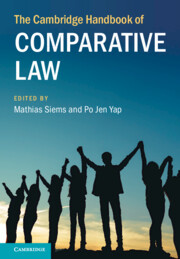Book contents
- The Cambridge Handbook of Comparative Law
- The Cambridge Handbook of Comparative Law
- Copyright page
- Contents
- Figures
- Tables
- Contributors
- Preface
- Abbreviations
- 1 Introduction
- Part I Methods of Comparative Law
- Part II Legal Families and Geographical Comparisons
- 11 Civil Law
- 12 Common Law
- 13 Confucian Legal Tradition
- 14 Former Soviet States of Eastern Europe, Caucasus and Central Asia
- 15 Latin America
- 16 Middle East and North Africa
- 17 South Asia
- 18 Sub-Saharan Africa
- Part III Central Themes in Comparative Law
- Part IV Comparative Law beyond the State
- Index
14 - Former Soviet States of Eastern Europe, Caucasus and Central Asia
from Part II - Legal Families and Geographical Comparisons
Published online by Cambridge University Press: 26 January 2024
- The Cambridge Handbook of Comparative Law
- The Cambridge Handbook of Comparative Law
- Copyright page
- Contents
- Figures
- Tables
- Contributors
- Preface
- Abbreviations
- 1 Introduction
- Part I Methods of Comparative Law
- Part II Legal Families and Geographical Comparisons
- 11 Civil Law
- 12 Common Law
- 13 Confucian Legal Tradition
- 14 Former Soviet States of Eastern Europe, Caucasus and Central Asia
- 15 Latin America
- 16 Middle East and North Africa
- 17 South Asia
- 18 Sub-Saharan Africa
- Part III Central Themes in Comparative Law
- Part IV Comparative Law beyond the State
- Index
Summary
The laws of the countries that emerged on the territory of the former Soviet Union show profound similarities due to a number of shared historical experiences. They have all been parts of the Russian Empire and the Soviet Union and have all gone, simultaneously albeit not uniformly, down the thorny path of post-socialist transition. The resulting common legacies concern deep-lying features of legal method as well as central structures of substantive law. The codification movement, institutional design, way of functioning and the role of the judiciary, and the extent of the professionalisation of law and the flaws of legal academia as well as the current state of property law and the law of legal persons provide prime examples. Disregarding these continuities results in distorted images based, in particular, on overemphasised formal similarities to the civil law family. Therefore, joint consideration of the formerly Soviet, but also formerly tsarist and formerly post-Soviet countries, remains an indispensable tool of legal comparison.
- Type
- Chapter
- Information
- The Cambridge Handbook of Comparative Law , pp. 275 - 301Publisher: Cambridge University PressPrint publication year: 2024



